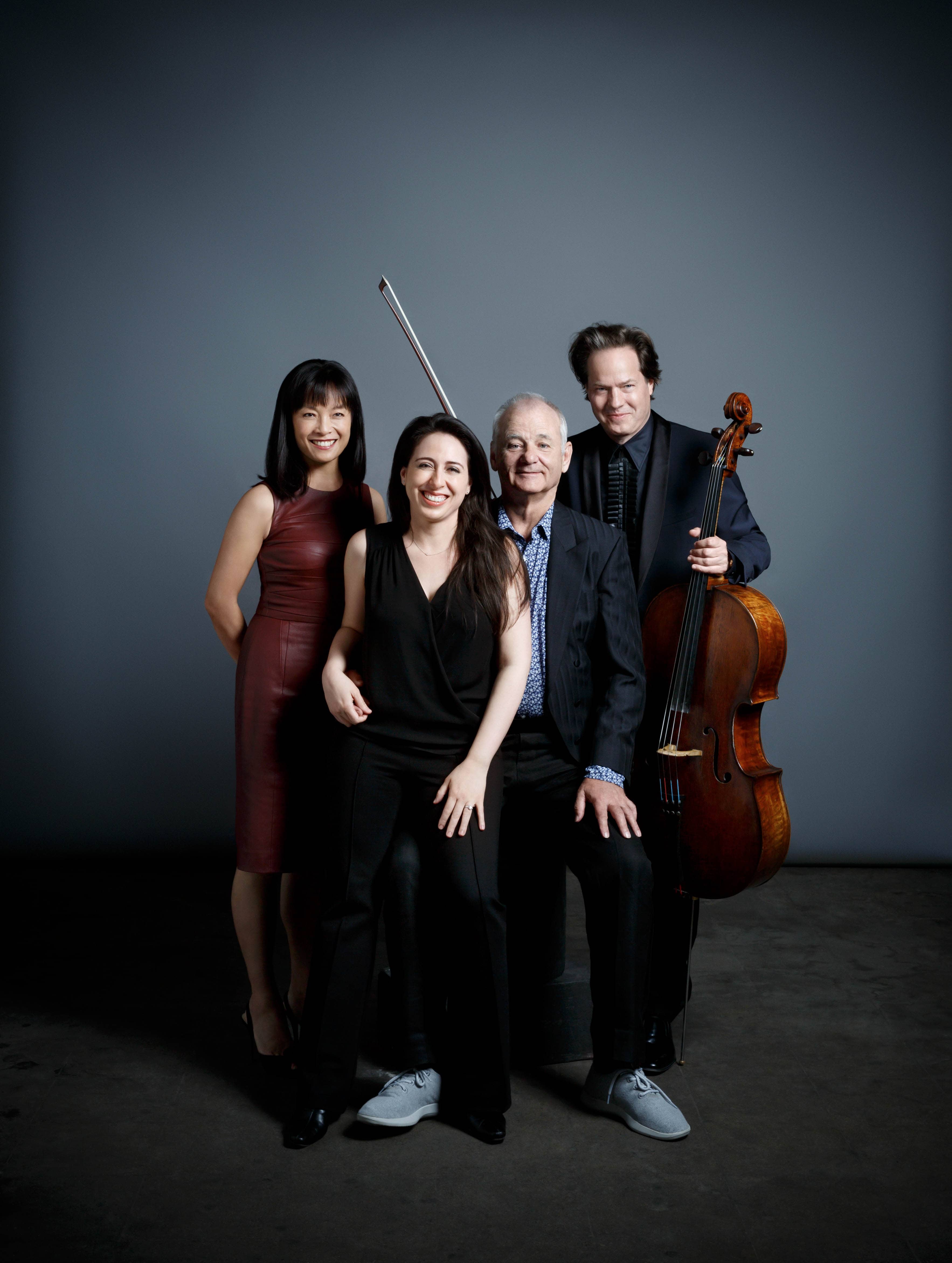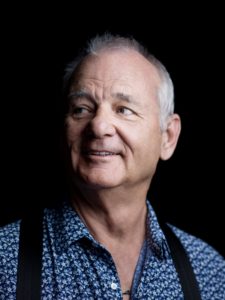Can you imagine a chamber music concert—a quartet, playing mostly classical work by composers with names like Bach, Schubert and Shostakovich—getting six encores?
And seven—yes, seven—standing ovations?
That’s what happened the other night when New Worlds—a one-night performance featuring Bill Murray and a trio of string players—took the stage for its Washington, DC premiere in the normally staid Concert Hall of the John F. Kennedy Center for the Performing Arts.

Murray, who won the Kennedy Center’s Mark Twain Prize for American Humor in 2016, has teamed up with Jan Vogler, the German cellist, for a world tour that celebrates the link between literature and music in a way that is likely to appeal to audiences of all ages.
The result is a dazzling form of entertainment, by turns whimsical, passionate, silly, hilarious, joyous, surprising and sad.
The tone of the show is set right at the beginning, when Murray, reading Ernest Hemingway, admits to having played the cello at his mother’s behest. “I played it worse than anything on earth,” he says, at which point Vogler cuts in with a Bach prelude so exquisitely composed and performed that it could well have been divine. (Vogler’s instrument is a 1707 Stradivarius.)
The strains of the Bach are still lingering in the air when Murray, switching to Walt Whitman, softly asks, “Hello. Who wishes to walk with me?” The words are so musical, there’s no need for accompaniment.
But then, suddenly, cello, violin and piano are all soaring in a Franz Schubert trio as Murray—now wearing a different hat—narrates a scene from James Fenimore Cooper’s Deerslayer. Schubert and Cooper, he tells us, loved each other’s work. (Who knew? And who, among us, has even thought about Cooper since grade school?)
Under Vogel’s invisible baton—the cellist is the concertmeister for the trio—Mira Wang, a former child prodigy (now turned virtuoso soloist), is the violinist and Vanessa Perez is the very gifted, funny and slightly manic pianist.
The serenity of Cooper’s forests is followed by the excitement of more Hemingway, this time with tales of women and booze, intersected by a Ravel sonata that hints of jazz and ragtime.
“In Paris, you could live very well,” Murray continues, now reading from Hemingway’s Moveable Feast. He remembers the strong appetites of artists and models. One of them, he confides, in a whisper that carries to the back of the hall, was a lesbian who also liked men.
Now the music is by Astor Piazzolla, the passionate Argentinian composer whose tangoes are as seductive as the unforgettable models.
Improbably, the violinist—dressed in a shimmering gold sheath—gets up to dance with Murray, swaying to the sound of the cello and piano playing Piazzolla’s incredibly romantic “Oblivion.”
Murray is a master of dialect. In his Hemingway vein, he gives us a Bulgarian waiter. In another segment, he is Jim, the runaway slave who is so close to freedom in Mark Twain’s Huckleberry Finn. He is also—as revealed in some of his films—a fine actor and uncanny mimic. His take on Billy Collins, the former Poet Laureate, is so good that I thought at first it was a recording. The same thing is true of his version of Van Morrison in “When Will I Ever Learn to Live in God.”
One of the saddest songs is “Jeanie with the Light Brown Hair” by Stephen Foster. It expresses the songwriter’s sorrow over the wife who left him. The song did not bring her back, nor did it make much money, but it did earn itself a permanent place in the American Songbook.
The pacing of the show is quite wonderful, with some numbers gliding into each other, while others sharply diverge. One of the best examples of a quick change is when the violinist and the pianist enter into a mad music competition based on “Chopsticks.” (That, too, is music.)
George Gershwin is here, as is Leonard Bernstein, with musical numbers from two of their greatest Broadway hits. In both cases, the literary aspect is literally the lyrics, written by Ira Gershwin for his brother’s Porgy and Bess and by Stephen Sondheim for West Side Story.
The Gershwin song is “It Ain’t Necessarily So.” Murray does a powerful rendition of the show-stopping number, urging the audience, at one point, to join in, and turning the concert hall audience into a rousing gospel choir.
He pulls off a different kind of switch when, in the show’s “official” finale (before the six encores), he sings the role of Maria in “I Feel Pretty” and “America,” both from West Side Story. He brings the house down when he points out that, contrary to what some people think, “Puerto Rico is in America.”

Of course, the finale is just the beginning. It’s not until the encores get started that Murray really lets loose. He jumps off the stage and somersaults back. He tosses flowers, one by one, to the audience and generally turns into a whirling dervish that threatens to spin out of time and space. At one point, he tells the audience that he’s already checked out of his hotel and since he has nowhere to go, he’d be happy to stay for the rest of the night.
In fact, there is so much physicality to this show that it’s hard to believe that Bill Murray is actually 67 years old, and that he got his start on Saturday Night Live more than 40 years ago.
New Worlds owes much of its strength to Vogler, who grew up in East Berlin in a house where there were lots of books, including Hemingway and Twain, but all in German. He and Murray met on a plane, where the latter was surprised to learn that the cello got its own seat – in first class, no less, and next to a window.
The show—whose levity makes chamber music approachable for many who might have backed off in the past—will continue its worldwide tour in 2018. Concerts are currently planned for other cities in the US, as well as Iceland, Europe and Australia.
Running Time: Two hours with encores, ovations and no intermission.
Bill Murray, Jan Vogler & Friends: New Worlds was performed on March 4, 2018 at The Kennedy Center, 2700 F Street, NW, in Washington, DC. For more information on upcoming shows at the Kennedy Center, go online.




